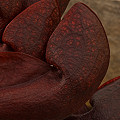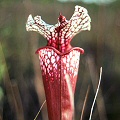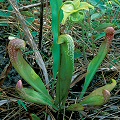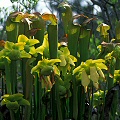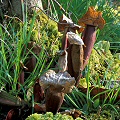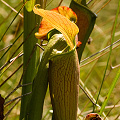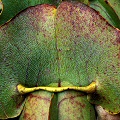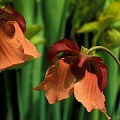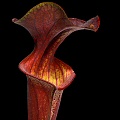Q: About Sarracenia hybrids
A: Now that you have heard about all the species and other entities within the genus Sarracenia,
do you think you are ready to run around in pitcher plant land and identify plants with ease and alacrity? Beware, for there
is yet another layer of complexity to this. Hybrids.
You see, in the genus Sarracenia, all the species can hybridize, and the
hybrids are fertile. (What!? Does that mean they are all one species? No,
you are using an overly restrictive kind of
"biological species concept" which is
more appropriate for animals than for plants).
Many Sarracenia hybrids occur naturally in the wild. This is not at all
surprising, since it is very common that a Sarracenia site will be home to more than
one species. If you visit such a site, you may see the "pure" parents, plus some plants which are clearly
hybrids. And in time, the hybrids often cross with each other or backcross with the parents, and you will end up with
something called a hybrid swarm. Hybridization is so active at some sites that it may be difficult to find examples of the
"pure" species that started the whole process. Hybrids often have a vigor that species do not--another reason they can
outgrow their parents.
I have "pure" in quotes above because some people argue that a "pure"
Sarracenia plant may just be a fiction. This argument has some validity, I think.
Usually the cross between two Sarracenia species (called an F1 hybrid) is easily spotted since
the hybrids are usually intermediate in appearance between the parents. In contrast, backcrosses can be very difficult to
detect because the effect of one of the parents may be almost completely invisible. For example, a
Sarracenia leucophylla that is particularly deep red and a little shorter and stocky than usual
may seem to be a really neat plant, but it may be that it is actually a back-cross with
Sarracenia rosea. Experienced naturalists discussing suspicious plants can sound like oenophiles at
a wine tasting:
"Hmm, I think I detect a slight rosea influence, don't you agree? "
"Oh, not at all! I think you're being misled by the rubra; the rosea,
if it is there, is being swamped by the other characters."
Some hybrids have Latin names. Some hybrids were given Latin names because they were thought to be pure species. Other hybrids
established in cultivation were given Latin names, but this is no longer scientifically fashionable.
(Yes, there is such a thing as fashion in science!) You
can identify a hybrid name by the appearance of an
"×" symbol. For example, the cross between
S. flava and S. purpurea is indicated by
S. flava × purpurea, and is also called S. ×catesbaei, or
sometimes just S. catesbaei, although the last usage can be very confusing. By the way, if your method
of publication can distinctly show a times symbol, you stick that right in front of the hybrid epithet
(like this: S. ×catesbaei), but if you only have access to the letter "ex", then
you use a space (like this: S. x catesbaei). Yes, I'm really giving you
the nitty-gritty details, but that's the kind of service you can expect from me, that you won't get at the other
web sites!
| Table 1: Sarracenia hybrids1 | ||
|---|---|---|
| Parent #1 | Parent #2 | Hybrid name |
| S. alabamensis | S. alata | --- |
| S. flava | ---2 | |
| S. jonesii | --- | |
| S. leucophylla | S. ×readii | |
| S. minor | --- | |
| S. psittacina | S. ×casei | |
| S. purpurea | --- | |
| S. rosea | ---2 | |
| S. alata | S. flava | --- |
| S. jonesii | --- | |
| S. leucophylla | S. ×areolata | |
| S. minor | --- | |
| S. psittacina | --- | |
| S. purpurea | --- | |
| S. rosea | S. ×exornata | |
| S. rubra | S. ×ahlesii | |
| S. flava | S. jonesii | --- |
| S. leucophylla | S. ×moorei | |
| S. minor | S. ×harperi | |
| S. psittacina | ---2 | |
| S. purpurea | S. ×catesbaei | |
| S. rosea | S. ×naczii | |
| S. rubra | S. ×popei | |
| S. jonesii | S. leucophylla | --- |
| S. minor | --- | |
| S. psittacina | --- | |
| S. purpurea | S. ×charlesmoorei | |
| S. rosea | --- | |
| S. rubra | --- | |
| S. leucophylla | S. minor | S. ×excellens |
| S. psittacina | S. ×wrigleyana | |
| S. purpurea | --- | |
| S. rosea | S. ×mitchelliana | |
| S. rubra | S. ×bellii | |
| S. minor | S. psittacina | S. ×formosa |
| S. purpurea | S. ×swaniana | |
| S. rosea | --- | |
| S. rubra | S. ×rehderi | |
| S. psittacina | S. purpurea | S. ×courtii? |
| S. rosea | S. ×courtii? | |
| S. rubra | S. ×gilpinii | |
| S. purpurea | S. rosea | --- |
| S. rubra | S. ×chelsonii? | |
| S. rosea | S. rubra | S. ×chelsonii? |
|
1Sarracenia oreophila has no named hybrids, so is not included in the table. 2This unnamed hybrid should be expected in the wild. |
||
It is preferred practice when discussing a hybrid to list the female first, but this doesn't matter with hybrid names. The table to the right lists all the F1 hybrids that have names. Seasoned carnivorous plant horticulturists might be intrigued by my treatment of the names in my table, because it includes the impacts of separating S. rosea from S. purpurea, and also be treating "S. rubra subsp. wherryi" as S. alabamensis subsp. wherryi. These impacts, partially summarized in Mellichamp (2008), are as follows:
- Sarracenia ×readii and S. ×casei are hybrids involving
S. alabamensis subsp. wherryi as one parent.
- Sarracenia ×exornata was based upon a plant from Theodore, Alabama. Therefore the name
designates a plant with Sarracenia alata × rosea ancestry. I know of no hybrid name for
Sarracenia alata × purpurea.
- Sarracenia ×catesbaei was based upon a plant from Chesterfield, South Carolina.
Therefore the name designates a plant with Sarracenia flava × purpurea ancestry. The
hybrid name for Sarracenia flava × rosea is S. ×naczii.
- Sarracenia ×mitchelliana was based upon a plant from Bay Minette, Florida. Therefore the name
designates a plant with Sarracenia leucophylla × rosea ancestry. I know of no hybrid name for
Sarracenia leucophylla × purpurea.
- Sarracenia ×bellii designates a plant with
Sarracenia leucophylla × rubra subsp. gulfensis ancestry.
- Sarracenia ×swaniana was based upon a plant from Shallotte, North Carolina. Therefore the
name designates a plant with Sarracenia minor × purpurea ancestry. I know of no hybrid name for
Sarracenia minor × rosea.
- Sarracenia ×courtii was based upon a plant developed in the UK in cultivation. I
do not know where the parent plants were originally collected, so I cannot determine if this is a cross indicating
Sarracenia psittacina × rosea or
Sarracenia psittacina × purpurea.
- Sarracenia ×gilpinii is a cross indicating
Sarracenia psittacina × rubra
gulfensis.
- Sarracenia ×chelsonii was based upon a plant developed in the UK in cultivation. I
do not know where the parent plants were originally collected, so I cannot determine if this is a cross indicating
Sarracenia rubra × rosea or
Sarracenia rubra × purpurea.
Incidentally, the Latin name for a cross applies to both the F1 cross and also to any kind of back cross involving the original
parents. So for example, S. flava × purpurea= S. ×catesbaei,
but also the backcross S. (×catesbaei) × purpurea =
S. ×catesbaei. This may seem strange until you remember that you never know the parentage of
a hybrid in the wild, even if only two species is present. Is it an F1 cross or a backcross? It does not matter in terms of
naming. Horticulturists who track their breeding program are perfectly allowed to use complex hybrid
formulae indicating backcrosses, such as
S. [(purpurea × flava) ×
(flava × purpurea)]×[(purpurea × flava) × flava].
But bear in mind that in botanical nomenclature, such a plant can still be referred to as
S. ×catesbaei.
There are other Latin names for more complex crosses. Do not think you can
just make up your own hybrid cross names. The names must be published in a
widely circulated journal, along with an appropriate description and standard
specimen, as described in the ICBN rules. Creating bogus Latinized names only contributes to confusion.
Valid Latin hybrid names I have encountered, which are not in my hybrid table, are as follows. (I have no idea if
any of these really involve S. rosea instead of S. purpurea.)
S. ×exculta = S.
(purpurea × flava) × minor
S. ×georgiana = S.
((purpurea × (purpurea × rubra)) ×
(minor × purpurea)
S. ×laschkei= S.
(purpurea × psittacina) × (flava × leucophylla)
S. ×sanderae = S.
leucophylla × ((flava × minor) ×
purpurea)
S. ×schoenbrunnensis = S.
(purpurea × psittacina) × ((flava × minor) ×
purpurea)
S. ×umlauftiana = S.
(purpurea × psittacina) × (leucophylla × psittacina)
S. ×willisii = S.
(purpurea × psittacina) × ((purpurea × flava) ×
purpurea)
Horticulturists can use hybridization to create interesting new plants. For example,
I have seen a hybrid bred by Bob Hanrahan which looks absolutely and completely like a plain old, regular
Sarracenia minor....but it has a red flower! And for several years I watched a plant grow
from seed into a beautiful red Sarracenia flava var. atropurpurea.
I prized this plant for its vigor and excellent red coloration. But the first time it flowered
it produced red petals, indicating its hybrid nature. Dang. Another plant I have is of unknown ancestry--maybe
with Sarracenia flava, S. alata, and
S. leucophylla in its veins--and it had quite pretty Iris-like orange
flowers. Orange flowers!
There is an tedious philosophical battle between those who love Sarracenia hybrids, and those who love only pure species. The arguments go
something like as follows:
Hybrid Haters: "Ugh! I hate hybrids! Pure species plants are beautiful
creations of nature. Each species has a natural history story to tell. There are so many variations of color and form
already represented among the species that any collector should be satisfied. Hybrids are unnatural, artificial, may be
unable to capture prey, and I have no room for them in my crowded greenhouse."
Hybrid Lovers: "They sure are pretty, aren't they? Sometimes hybrids are much more vigorous than pure
species. Making them is a creative process, much like an art. Furthermore, hybrids occur in nature, don't they? And anyway,
who cares if they aren't "natural"? What kind of criterion is that?"
HH: "I can't believe you can espouse that argument! You are the
one who's not natural!"
HL: "Back off, nutso!"
HH: "Nutso? NUTSO? Look at the way you dress!"
HL: "That's called fashion sense, pig-boy."
...and so it goes. Entertaining, but it gets tiresome quickly.
Grow whatever you want. Enjoy your plants. From a
horticultural standpoint, grow Sarracenia hybrids just like you grow the pure species.
If you are shopping for good hybrids, look at my cultivar comments on the next page for recommendations.
Page citations: Greuter, W., et al. 2000;
Mellichamp, L. 2008;
Rice, B.A. 2006a; Schlauer, J. 2002; personal observations.
